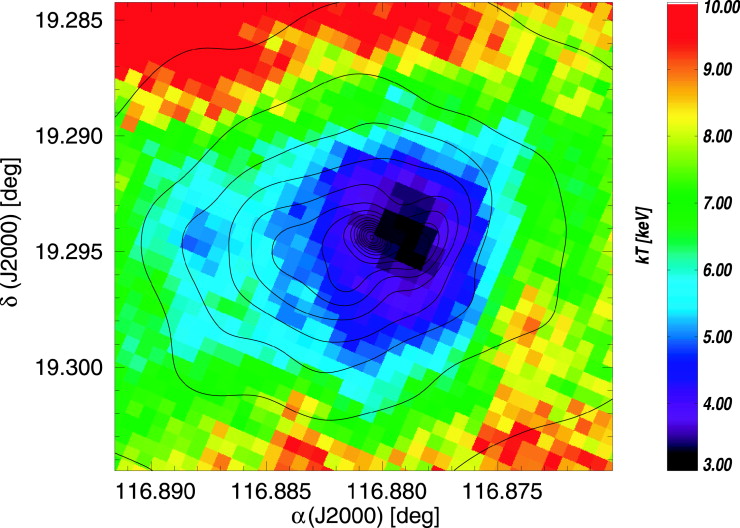
 "
Credit: Hicks et al., The Astrophysical Journal, vol. 580, pp. 763773, 2002 December 1
"
Credit: Hicks et al., The Astrophysical Journal, vol. 580, pp. 763773, 2002 December 1
Cool Cluster Core
Clusters of galaxies are the largest gravitationally bound objects in the
Universe. By studying these objects astronomers can put constraints on models of
how the Universe formed and will evolve. Such clusters contain large amounts of
gas at temperatures of 10 to 100 million degrees heated by the motion of the
member galaxies and from explosions of stars in those galaxies. This gas is
invisible to the human eye but glows brightly in X-rays, making X-ray
observations a unique probe of cluster properties. The Chandra X-ray Observatory is providing
some of the best views of the hot intracluster gas. The above image shows a Chandra
observation of the cluster PKS 0745-191. The map above shows the variation
in temperature in the cluster as a color map; cool gas (at temperatures of
"only" 3 kilo-electron volts, or keV, equivalent to about 30 million degrees)
are shown as black-blue, while the hottest gas (temperatures of 10 keV, or about
100 million degrees) is red. Gas is coolest near the center of the cluster
(shown by the contour lines) and gets appreciably hotter near the outer part of
the cluster.
Last Week *
HEA Dictionary * Archive
* Search HEAPOW
* Education
Each week the HEASARC
brings you new, exciting and beautiful images from X-ray and Gamma ray
astronomy. Check back each week and be sure to check out the HEAPOW archive!
Page Author: Dr. Michael F. Corcoran
Last modified December 1, 2002


 "
"